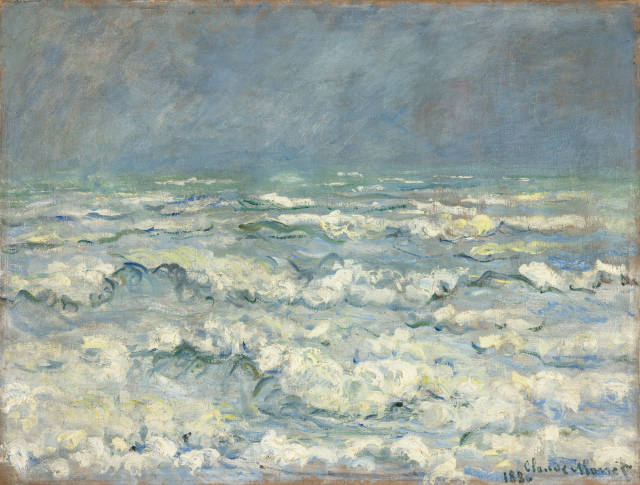- EN
Log in
- Live Auctions
- Past auctions
- More
- Gallery
- Art Dealing
- Publishing
- Kornfeld today
- The Story of Kornfeld
- Information







Paris 1840 - 1926 Giverny
1880
Oil on canvas
55.5x74 cm
Signed and dated "Claude Monet / 1880" by the artist lower right. Titled "Mer gros temps" on the reverse of the chassis and titled "Pleine mer, gros temps" on the label
Daniel Wildenstein, Monet, Vie et œuvre, vol. I, Lausanne/Paris 1974, no. 624
Studio of the artist, Vétheuil, purchased there in February 1881 by
Galerie Durand-Ruel, Paris, (stock no. 1733), acquired there on 6 January 1919 by
Galerie Bollag, Zurich
Acquired through the mediation of Jos Hessel (1859-1942), Paris/Brussels from
Collection Emil Hahnloser (1874-1940), by inheritance to
Collection Hedy Hahnloser, Winterthur, by inheritance to
Private collection Switzerland
Oscar Reuterswärd, Monet, En konstnärshistorik, Stockholm 1948, p. 281
Margrit Hahnloser-Ingold (ed.), Die Sammlung Arthur und Hedy Hahnloser Winterthur, Mit den Augen des Künstlers, Bern 2011, p. 35, ill. p. 39
Paris 1914, Galerie Durand-Ruel, Monet, cat. no. 46
Lucerne 1940, Kunstmuseum, Die Hauptwerke der Sammlung Hahnloser, Winterthur, cat. no. 73, p. 22, ill. tf. 3 (there titled "La mer à Étretat")
Bern 1953, Kunstmuseum, Europäische Kunst aus Berner Privatbesitz, cat. no. 83
Vienna 2020, Albertina, Van Gogh, Cézanne, Matisse, Hodler, Die Sammlung Hahnloser, cat. no. 18, p. 132 ff.
On the original chassis in the old nailing. Slightly craquelure. In very good condition
The surf on the Atlantic coast of Normandy near the village of Petites-Dalles on a stormy September day in 1880 was the subject of Claude Monet's interest when he conceived this painting. He focused on the phenomenon of the crashing waves with their white crests and the atmospheric lighting conditions under an overcast sky. In the same autumn, Monet created three more paintings using this stretch of coastline on the English Channel in Seine-Maritime as a motif. The stretch of beach with its rocky cliffs was very popular with foreign holidaymakers and locals alike. Two paintings show the beach with the steep chalk cliffs and the view of the sea. The third painting, entitled "The Wave", testifies to Monet's interest in depicting the moving surface of the sea and at the same time shows his preference for fragmentary details. The pictorial device of limited space enables a focused, detailed view. With "Pleine mer, gros temps", Monet achieved a masterful combination of pictorial atmosphere and light effect, and at the same time the painting could be a homage to the important exponent of the Barbizon School: the painter Gustave Courbet, who set new standards in landscape painting with his monumental painting "Stormy Sea" from 1870, also known as "The Wave", and helped this genre to gain increasing recognition and importance towards the end of the 19th century.
1880
Öl auf Leinwand
55,5x74 cm
Unten rechts vom Künstler signiert und datiert "Claude Monet / 1880". Rückseitig auf dem Chassis betitelt "Mer gros temps" bzw. auf Etikett betitelt "Pleine mer, gros temps"
Daniel Wildenstein, Monet, Vie et œuvre, Bd. I, Lausanne/Paris 1974,
Atelier des Künstlers, Vétheuil, dort Februar 1881 angekauft von
Galerie Durand-Ruel, Paris, (Lager-Nr. 1733), dort am 6. Januar 1919 erworben von
Galerie Bollag, Zürich
Durch Vermittlung von Jos Hessel (1859-1942), Paris/Brüssel erworben von
Slg. Emil Hahnloser (1874-1940), durch Erbschaft an
Slg. Hedy Hahnloser, Winterthur, durch Erbschaften an
Privatsammlung Schweiz
Oscar Reuterswärd, Monet, En konstnärshistorik, Stockholm 1948,
Margrit Hahnloser-Ingold (Hrsg.), Die Sammlung Arthur und Hedy Hahnloser Winterthur, Mit den Augen des Künstlers, Bern 2011,
Paris 1914, Galerie Durand-Ruel, Monet,
Luzern 1940, Kunstmuseum, Die Hauptwerke der Sammlung Hahnloser, Winterthur,
Bern 1953, Kunstmuseum, Europäische Kunst aus Berner Privatbesitz,
Wien 2020, Albertina, Van Gogh, Cézanne, Matisse, Hodler, Die Sammlung Hahnloser,
Leichte Kraquelüren. Auf dem originalen Chassis in der alten Nagelung. In sehr guter Erhaltung
Der Brandung an der Atlantikküste der Normandie in der Nähe des Ortes Petites-Dalles an einem stürmischen Septembertag des Jahres 1880 galt Claude Monets Interesse bei der Konzeption dieses Gemäldes. Dabei konzentrierte er sich auf das Phänomen der sich überschlagenden Wellen mit ihren weissen Schaumkronen und auf die stimmungsvollen Lichtverhältnisse bei bedecktem Himmel. Im selben Herbst schuf Monet drei weitere Bildschöpfungen, denen dieser Küstenabschnitt am Ärmelkanal im Département Seine-Maritime als Bildmotiv diente. Der Strandabschnitt mit seinen Felsklippen war bei ausländischen Urlaubsgästen wie bei Einheimischen sehr beliebt. Zwei Gemälde zeigen den Strand mit den steil abfallenden Kreidefelsen und der Sicht aufs Meer. Das dritte Gemälde mit dem Titel "Die Welle" bezeugt Monets Interesse an der Darstellung der bewegten Meeresoberfläche und zeigt gleichzeitig seine Vorliebe für fragmentarische Bildausschnitte. Das bildgestalterische Mittel des begrenzten Raumes ermöglicht ein fokussiertes, detailbezogenes Betrachten. Mit "Pleine mer, gros temps" gelang Monet eine meisterhafte Verbindung von Bildatmosphäre und Lichtwirkung, und gleichzeitig könnte das Gemälde eine Hommage an den wichtigen Exponenten der Schule von Barbizon sein: an den Maler Gustave Courbet, der mit seinem monumentalen Gemälde "Stürmische See" aus dem Jahr 1870, bekannt auch unter dem Titel "Die Welle", neue Massstäbe in der Landschaftsmalerei setzte und dieser Gattung gegen Ende des 19. Jahrhunderts zu zunehmender Anerkennung und Bedeutung verhalf.
| Switzerland | CHF | 200 |
| Europe | CHF | 300 |
| USA | CHF | 390 |
| Overseas | CHF | 430 |








